Seven days in Tibet – episode 3
SHIGATSE
Fortunately, the girls feel better during the next morning, so as 9 new musketeers band, we spend an extra night in the next city, Shigatse, about which I know is one of the most alltered cities of Tibet. Certainly not alone.
The road to Shigatse offers us the same spectacular scenery of the Tibetan plateau, as well as the entire route to Lhasa. For me is very surprising the meeting with groups of cyclists that run athigh altitudes of over 5000m. Swiss, Germans about 40-50 y.o. give me anendurance lesson, covering thousand miles by the bike, the opposite of us, giving a whole new dimension to the notion of mountain biking. With a stop in Lhotse to eatcurry chicken, a yakburger, a Noodle soup, a tea masala, watched out of the restaurant window by hungry eyes of mothers and children, here we are in Shigatse, the regional capital Tsang. Here the hotel comes as a godsend after the first Tibetan nights. Heat sheets that seem even to have been washed and a glass-walled bathroom. The appearance of the aquarium bath awakens the suspicion that this area was actually for fishes. An attempt to use the Internet at hotel’s reception reminds me where I am. Facebook and Gmail “are not allowed in China,” the receptionist told me after I asked him to translate the illegible writing on the screen. OK, I have the phone, unlike Nepal, here is roaming.
Instead the buffet, but yet a Chinese one, some of us choose to have dinner out, in town that we are curious to discover it, how else than using a rickshaw. Here, the same as in Kathmandu, in the rickshaw, I feel like all I need is a whip, to became a clasic exploiter. Alos, I understand that because of people like us, tourists, these people have the meal assured in every evening. That’s why even now I do not negotiate the price the man asked me. On a commercial street lined by two Tibetan red gates, we enter in the Tibetan Family, an intimate restaurant, populated at this time only by the locals, that’s always a good sign. While I was going through the kitchen on the way to the bathroom, thatdid not look very inviting, yet I enjoyed the delicious Yak Momos, with the live Tibetan songs singing also by the Chef,across the kitchen door blanket. The girl who serves us is equally delicious when shegives up any response to our questions, even so, with a humble “sorry”. We return to the hotel and we ended the day with a washed in days’ impressions Lhasa beer.
The morning reveals the second city of Tibet as being incredibly polluted. I don’t understand how at over 3,800m altitude, without being very heavy traffic, the air on the sidewalk is unbreathable. Suddenly, the mystery of cloth masks on people’s faces are wasted. But not the invisible cloud of the exhaust gas who away us quickly from the streets.
We find the refuge at Tashilhunpo, residence of Panchen Lama (Tashi). It is now chosen by the Chinese, the true one, chosen in 1995 by the Dalai Lama is now “gone”. Because Panchen plays an important role in choosing the next Dalai, everything is connected. The monastery is in my opinion, more like a museum than a place of worship. No wonder, in 1961, its patrimony, together with the holy relics, have been owned by the People’s Republic. That’s why stupas with Dalai and Panchen Lama remain are not seen. Asked why, however, our Tibetan guide Lhakpacan not answer. He has the same fearful retention every time we enter on a sensitive area with our questions. We choose to spare him. The words that would like to shout out loud, but veiled whispers to us, brings tears to his eyes.
- Șapte zile în Tibet – Shigatse
- Șapte zile în Tibet – Shigatse
- Șapte zile în Tibet – Shigatse
- Șapte zile în Tibet – Shigatse
- Șapte zile în Tibet – Shigatse
The monastery, founded in 1447 by the first Dalai Lama, houses the highest sitting Maitreya Buddhain the world – the future Buddha – and is one of the four monasteries of the Yellow Caps (Gelukpa) of Tibetan Buddhism. If you want to have photos as evidences of your passage through the many chapels, you have to fork out tens of yuans for each of them. Not much you can cheat, because the monks, who have found they are mostly Chinese, are very vigilant. Besides, who wants a bad karma? So I summarize more to listen to theguide’sexplanations. When we entering in each room we hear the sentence: “In this chapel you can see many statues”, followed by explanations. Among the dozens, hundreds of representations of the Buddha, formerDalai and Panchen Lamas, I managed to retain only the Buddha of Compassion, the one with a thousand arms. Otherwise, the guide’s English having an impossible accent, even the size of this religion enthusiasm, cut my enthusiasm that I started on the path of enlightenment. The complex is actually a small city, with temples, stupas, cells with windows and doors decorated with flounces of white cloth, which discreet lycurl in the light breeze.
At exit, there is a cold square with natural size bronze statues, representing the meeting between the Tibetans and the Western tourists. The rest of the day, decreed by our guide as “leisure”, we dedicated to explore the old city. Now, we met for the first time with the Tibetan fair, especially with extremely fun and profitable Tibetanbargaining. Behind the stalls filled with all kindsornaments, from turquoise and other semiprecious cornalinsmade, with prayer wheels and bells, statues, singing bowls, women dressed in traditional costumes entice you, “looky, looky! I gi’tzeep, tzeep“. When we asked ”how much?” the answer invariably is ”how you gimmymutzi“. Here it begins a long and sometimes aggressive bargaining, which delights the Tibetan shopping sessions, especially for one of the group’s girls, who discovered her hidden negotiating talents.
Wandering the side streets, including houses, shops and workshops, is an important part of finding out a place. How else to taste some gelatinous and uncertain green stuff ,to be your sermons about harmfulness of smoking by a ten years aged boy, to watch a snooker game in the street, to beat a drum to prayer, to see how it dries noodles, how they paint the furniture or how a master blacksmithasks you a print photo just after you photo him with the digital camera.
We wake up flying out on the pathsgoing up to the dzong city, Samdrubtse, along the rows of prayer wheels and Mani wheels, so called because the inscription “Om manipadme hum” the mantra of Avalokiteshvara, the reincarnated Dalai Lama. Castle-fortress served as a model for the Potala Palace, before it with a couple of centuries. Unfortunately, the present dzong is a concretecopy of the original one, destroyed by “you know by whom” in the ’60s. From the height, we surprise … we can see in the middle of the city a blue mosque
- Șapte zile în Tibet – Shigatse
- Șapte zile în Tibet – Shigatse
- Șapte zile în Tibet – Shigatse
- Șapte zile în Tibet – Shigatse
- Șapte zile în Tibet – Shigatse
- Șapte zile în Tibet – Shigatse
Any town, however dull it may seem at the first view, may surprise you, if you know where to look.





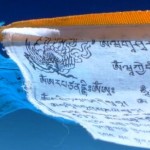



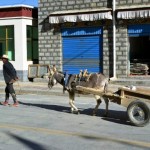
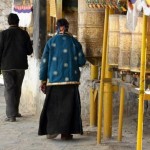
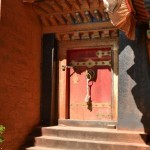
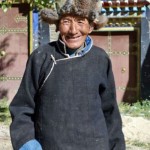
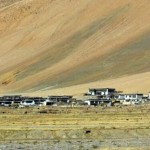

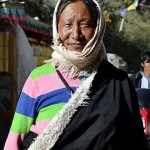


ai multe portrete si asta imi place…